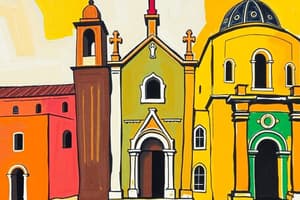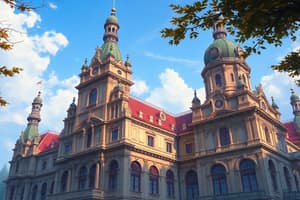Podcast
Questions and Answers
What is a key feature of Baroque architecture?
What is a key feature of Baroque architecture?
- Simple facades
- Angular shapes
- Minimal ornamentation
- Bold ornamentation (correct)
What is the purpose of using natural light in Baroque architecture?
What is the purpose of using natural light in Baroque architecture?
- To highlight the simplicity of the design
- To reduce the use of artificial lighting
- To create a sense of intimacy
- To create dramatic contrasts (correct)
What style of columns are featured on the facade of St. Peter's Basilica?
What style of columns are featured on the facade of St. Peter's Basilica?
- Tuscan
- Corinthian (correct)
- Doric
- Ionic
What is the significance of the oval and elliptical shapes in Baroque architecture?
What is the significance of the oval and elliptical shapes in Baroque architecture?
What is the purpose of the grand domes and high ceilings in Baroque architecture?
What is the purpose of the grand domes and high ceilings in Baroque architecture?
What is the location of St. Peter's Basilica?
What is the location of St. Peter's Basilica?
What is St. Peter's Basilica a synthesis of?
What is St. Peter's Basilica a synthesis of?
What is the significance of the facade of St. Peter's Basilica?
What is the significance of the facade of St. Peter's Basilica?
Who designed the dome of St. Peter's Basilica?
Who designed the dome of St. Peter's Basilica?
Who designed the nave of St. Peter's Basilica?
Who designed the nave of St. Peter's Basilica?
What is the purpose of the baldachin in St. Peter's Basilica?
What is the purpose of the baldachin in St. Peter's Basilica?
Who designed the piazza in front of St. Peter's Basilica?
Who designed the piazza in front of St. Peter's Basilica?
What is the characteristic of Baroque gardens?
What is the characteristic of Baroque gardens?
What was the purpose of medieval gardens in Italy?
What was the purpose of medieval gardens in Italy?
What is the feature of Italian Renaissance gardens?
What is the feature of Italian Renaissance gardens?
Who assisted in completing the dome of St. Peter's Basilica after Michelangelo's death?
Who assisted in completing the dome of St. Peter's Basilica after Michelangelo's death?
What is the primary purpose of the Lourdes Grotto in the Vatican Gardens?
What is the primary purpose of the Lourdes Grotto in the Vatican Gardens?
What is unique about the Berthier Gallery in the palace of Isola Bella?
What is unique about the Berthier Gallery in the palace of Isola Bella?
What is the notable characteristic of the gardens in the Vatican Gardens?
What is the notable characteristic of the gardens in the Vatican Gardens?
What is the name of the lake where Isola Bella is located?
What is the name of the lake where Isola Bella is located?
What is the distinctive feature of Baroque architecture and garden design?
What is the distinctive feature of Baroque architecture and garden design?
What is the layout of the gardens in Isola Bella?
What is the layout of the gardens in Isola Bella?
What is the purpose of the dramatic elements in Baroque architecture and garden design?
What is the purpose of the dramatic elements in Baroque architecture and garden design?
Flashcards are hidden until you start studying
Study Notes
Baroque Architecture
- Characterized by extravagant decoration, curves, painted ceilings, dramatic use of light, bold ornamentation, and a sense of movement and grandeur.
- Part of the Counter-Reformation's effort to attract and inspire the faithful through awe-inspiring designs.
- Uses natural light to create dramatic contrasts and highlight architectural elements.
- Richly decorated facades and interiors with sculptures, stuccoes, and frescoes depicting religious themes.
- Curved forms, such as oval and elliptical shapes, dynamic facades, and undulating surfaces create a sense of movement.
- Large domes, high ceilings, and expansive spaces create a sense of awe and heavenly ascent.
St. Peter's Basilica, Vatican City
- One of the most renowned works of Renaissance and Baroque architecture.
- Synthesis of Renaissance and Baroque architectural styles, embodying the artistic and structural advancements of the period.
- One of the largest churches in the world.
- Built over the traditional site of St. Peter's tomb, with a rich architectural history and contributions from several illustrious architects.
Façade
- Designed by Carlo Maderno and completed in 1614.
- Massive structure featuring a central entrance flanked by colossal Corinthian columns and pilasters.
- Crowned by a giant pediment and statues of Christ, apostles, and saints.
Dome
- Designed by Michelangelo, one of the largest in the world.
- Supported by four massive piers and rises to a height of 136.57 meters (448.1 feet) from the floor of the basilica to the top of the cross.
- Iconic symbol of the basilica, visible from across Rome.
Nave
- Designed by Carlo Maderno, vast and richly decorated.
- Features a coffered barrel vault and is lined with a series of chapels and niches.
- Interior decoration includes works by renowned artists, including Bernini's Baldachin over the papal altar.
Canopy / Baldachin
- Designed by Gian Lorenzo Bernini, a masterpiece of Baroque sculpture.
- At the center of the crossing, directly under the dome of the basilica.
- Intended to mark, in a monumental way, the place of Saint Peter's tomb underneath.
Piazza
- Elliptical piazza in front of the basilica, designed by Gian Lorenzo Bernini.
- Enclosed by a monumental colonnade consisting of four rows of Doric columns.
- Sweeping arms of the colonnade embrace visitors in a grand architectural gesture, serving as a space for large gatherings.
Architectural Contributions
- Donato Bramante: Initial architect of the new basilica, appointed by Pope Julius II in 1506.
- Michelangelo Buonarroti: Simplified Bramante's plan, designed and supervised construction of the dome.
- Giacomo della Porta: Assisted in completing the dome after Michelangelo's death.
- Carlo Maderno: Extended Michelangelo's plan to a Latin cross, creating the nave and façade.
- Gian Lorenzo Bernini: Played a significant role in interior decoration and design of the piazza and colonnade.
Baroque Gardens
- Prior to the Renaissance, Italian medieval gardens were enclosed by walls, devoted to growing vegetables, fruits, and medicinal herbs.
- Italian Renaissance garden broke down the wall between the garden, house, and landscape outside.
- Baroque gardens became outdoor extensions of interior living spaces, more elaborate than Renaissance Gardens.
- Often enormous and complex, containing statuary and water features, with a goal of sweeping vistas towards the sea, lakes, and mountains.
Vatican Gardens
- Date back to medieval times, originally orchards and vineyards extending north of the Papal Apostolic Palace.
- Historically a place of reflection and retreat for the Popes since the early 13th century.
- Successive Popes contributed to development and beautification, adding chapels, grottoes, and monuments.
- Notable feature: Lourdes Grotto, a replica of the Grotto of Massabielle in Lourdes, France, serving as a place of pilgrimage and prayer.
Isola Bella
- A prime example of Baroque architecture and formal gardens on a small island in Lake Maggiore.
- Construction of the Villa Borromeo and its gardens began in 1632, finally inaugurated in 1671.
- Palace features grand staircases, richly decorated rooms, and intricate frescoes.
- Interiors lavishly decorated with stucco, tapestries, and period furniture, with paintings and sculptures by renowned artists.
- Berthier Gallery is an amazing art museum, with many original and handmade copies of famous works.
- Garden design takes full advantage of the island's natural setting, offering stunning views of Lake Maggiore and surrounding mountains.
- Ten terraces resembling a stepped pyramid, with numerous statues, obelisks, and fountains, designed to impress and delight visitors.
- Gardens follow a highly symmetrical and geometric plan, contrasting with the natural landscape, emphasizing Baroque control and artifice.
Studying That Suits You
Use AI to generate personalized quizzes and flashcards to suit your learning preferences.




